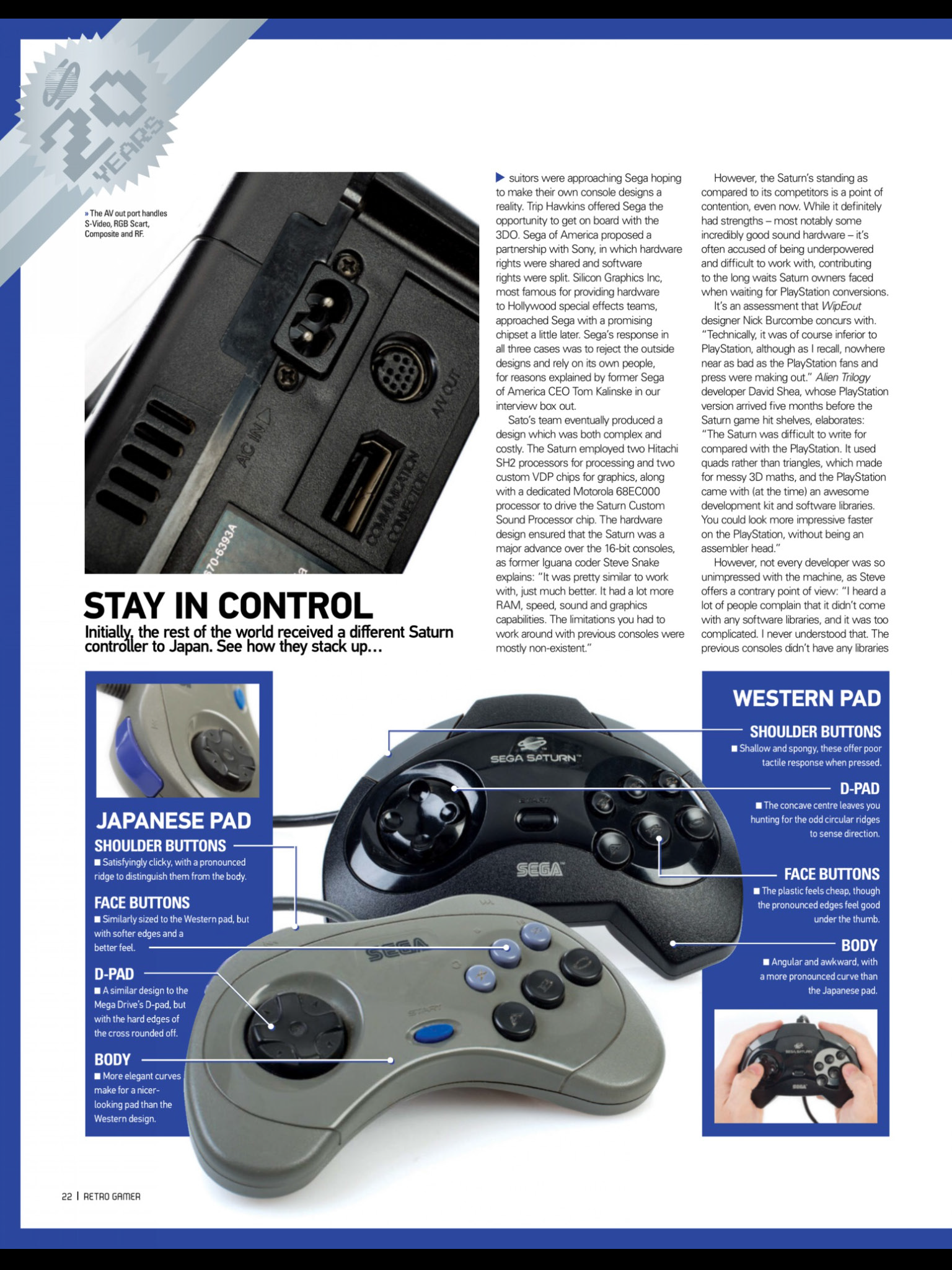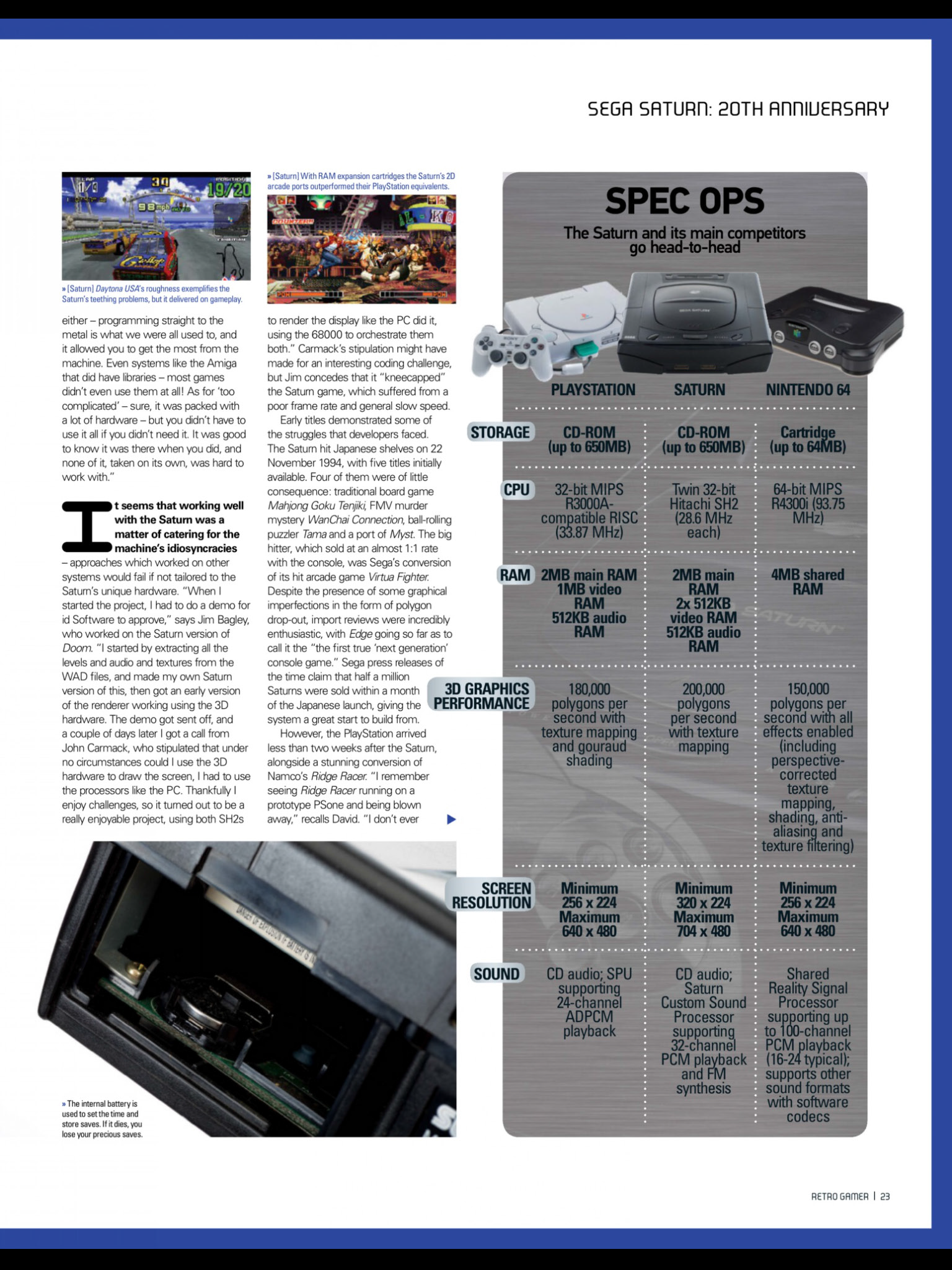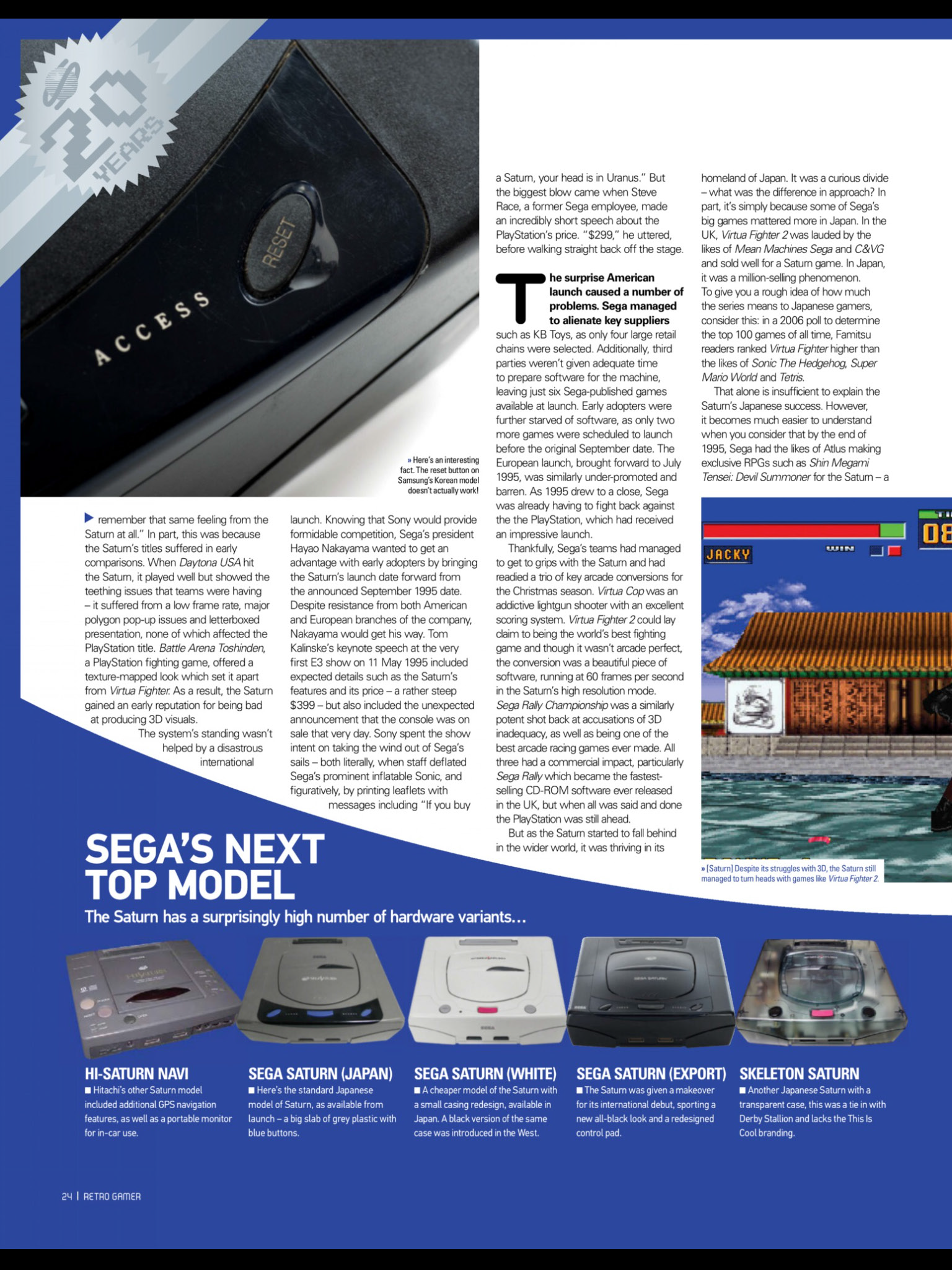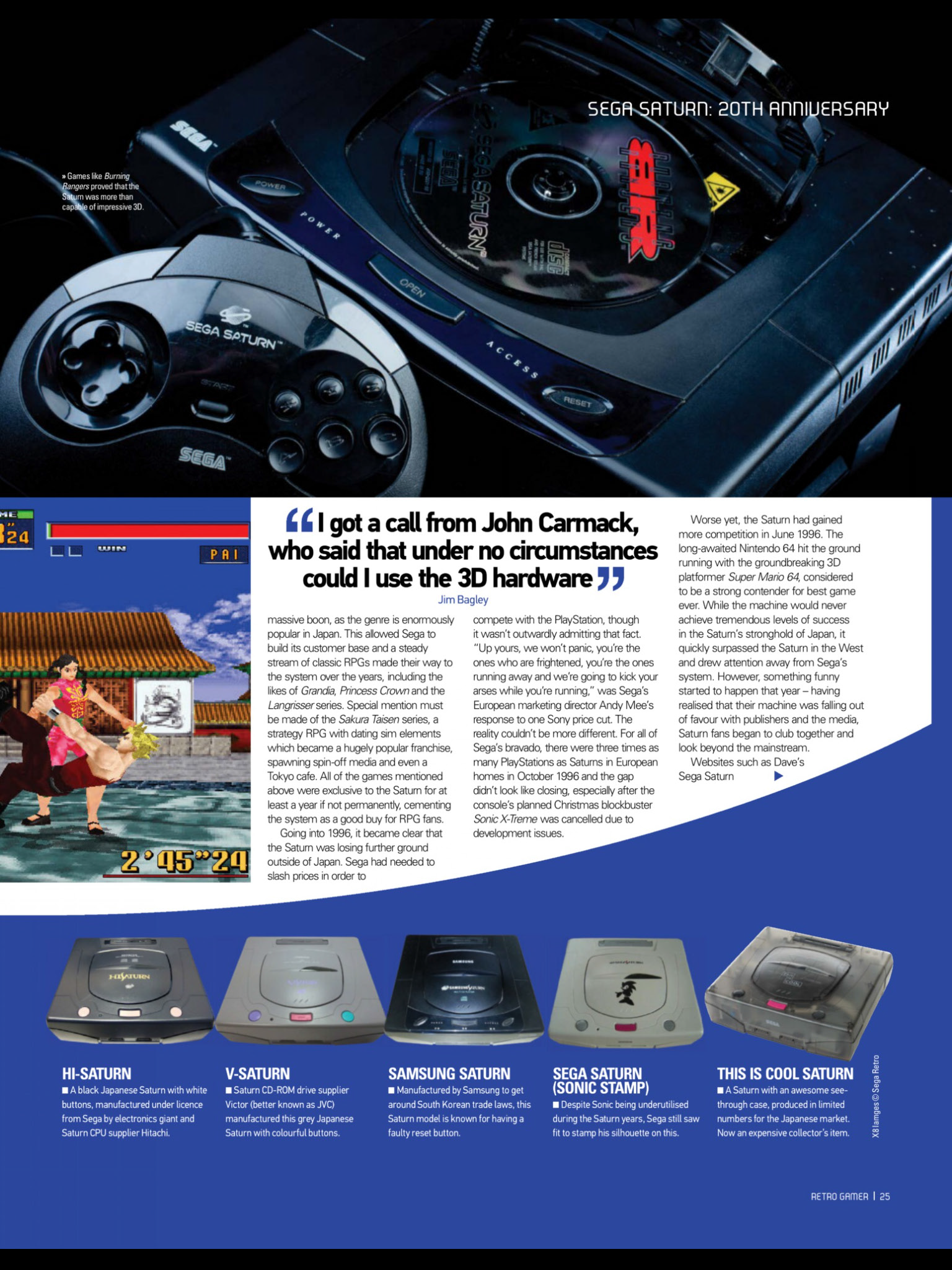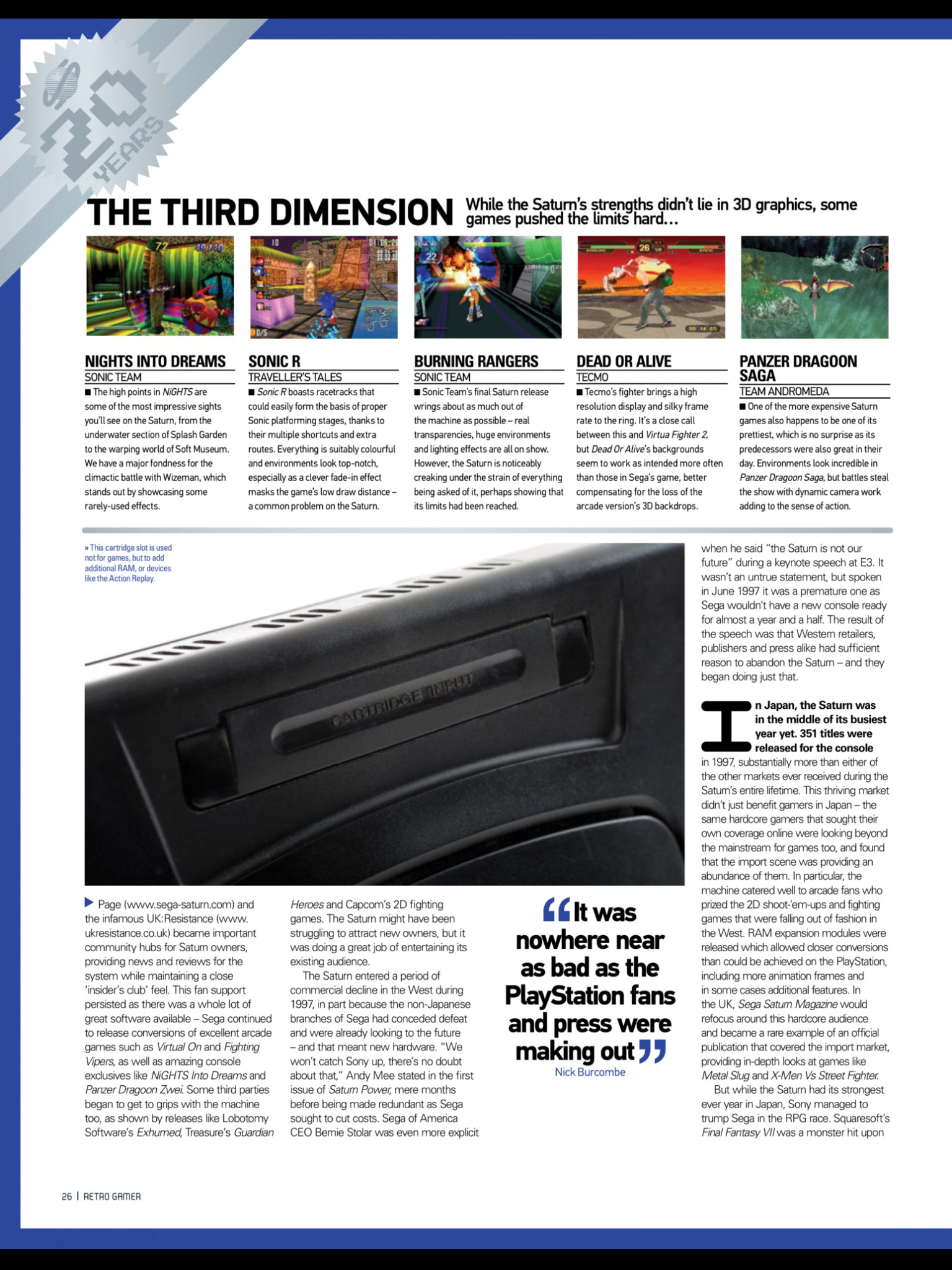Retro Gamer
Issue 77
Review of Damien McFerran's "Retroinspection: Sega 32X"
Introducing his editorial on the 32-bit add-on for the Sega Genesis, Damien McFerran, co-maintainer of the Mean Machines Archive1 and Nintendo Life2, offers his very subjective opinion. "How do you take half a decade's worth of critical and commercial success and flush it down the toilet," McFerran posits, "Easy: you release a device like the Sega 32X." 3 Asserting that Sega was "at the height of its powers" by 1990, but "took far too many risks" with hardware by 1995, McFerran fails to cite which industry experts claim that the "commercially disappointing" Mega CD was a prelude to the "disastrous retail performance" of the 32X.4 McFerran similarly offers a crude history of the 32X and Saturn at retail before introducing Scot Bayless, Senior Producer at Sega of America from 1990-1994.5 The subsequent several pages are exemplary of the hostility towards Sega hardware that has accumulated over the last fifteen years. The comments of Scot Bayless and Marty Franz published in these pages challenge and disprove a number of common fallacies surrounding the 32X, and even some for the Saturn's development. McFerran, however, only posits hyperbolic questions and maintains an extremely negative tone throughout his six page editorial.
Bayless recalls the 32X development origins at Winter CES 1994 in Las Vegas. Joe Miller, Head of Sega of America Research and Development, called Bayless and a couple of others into a teleconference with Hayao Nakayama. The call resulted in a move away from an enhanced Megadrive, apparently being worked on by Sega of Japan's Hideki Sato, toward a response to Atari's Jaguar. To which Joe Miller, according to Bayless, pushed for letting Sega of America develop a solution. Nakayama agreed, and the 32X was conceived on a hotel notepad when Marty Franz sketched two Hitachi SH-2 processors with individual frame buffers. Bayless continued by explaining that Sato's "Jupiter" was squeezed out due to cost factors by the 32X. McFerran then interjects his first positive statement: "From an engineering standpoint, the machine certainly had a lot of potential." 6 Bayless opines that the 32X's graphics subsystem was "brilliantly simple: something of a coder's dream" with "twice the depth per pixel of anything else out there." 7 The way the 32X handles 3D, Bayless supposes, was not being attempted "outside the workstation market." 8 In spite of all of this, McFerran bookends the first and second pages with an enlarged self-quote of the 32X being "the straw that broke the camel's back" and one of Bayless more baseless assertions that 32X's mere existence made Sega "look greedy and dumb to consumers." 9
McFerran describes "much brow-forrowing" at Sega of Japan due to the Megadrive's third place status in Japan and their "consensus" that all available resources should have been focused on Saturn.10 Apparently in direct conflict with this consensus was Nakayama himself, who took notice of the Genesis' "incredible commercial performance" and Sega of America's subsequent insistence of its continued marketability. Bayless recalls "there was a consensus at Sega of America that making an add-on for the Megadrive was the right move." 11 Nakayama's ensuing call to get the 32X out by the end of 1994 was due, Bayless suspects, to his doubt on whether "the Saturn would make it to market within 1994." 12
Suppositions about how, or whether, the 32X and Saturn would coexist seemed to abound at Sega of America at least. Despite McFerran's assertion of a consensus against the 32X in the parent company, Bayless remembers "the guys at Sega of Japan were great - especially Sato's team." 13 Any perceived tension between Sega's branches at the time are attributed to the "super double-secret-crunch-mode" and frayed nerves over delays such as the two week pause when the 32X development kit had one of its SH-2s fail. "The guys in Japan were awesome," Bayless persists, "they worked their tales off to help us." 14 The only problem Bayless notes was the difficulty in translating English hybrid "technical Japanese" documentation, which was being sent to Sega of America as it was being written.
McFerran, here, fails to notice that Bayless' account shows Sega of Japan was engineering the 32X based on Sega of America's work. The writer does note that the 32X and Saturn shared the same CPUs but used them very differently. Oddly, Bayless describes the Saturn's usage of quadrilaterals as "essentially a 2D system with the ability to move four corners of a sprite ... [to] simulate 3D space." 15 Continuing that the Saturn's hardware rendering was bottlenecked by a "very high" pixel overwrite rate and "memory access stalls," Bayless shows preference for his team's design.16 These supposed problems with the Saturn being as much dependent on the quality of the code as the 32X's ability to display 3D at all seems to escape Bayless' notice.
The 32X doing "everything in software" but having "two fast RISC chips tied to great big frame buffers and complete control to the programmer" causes Bayless to lament that the Saturn had not adopted a similar approach. Bayless' next statement should not be missed, "that ship had already sailed long before the green light call from Nakayama." Depending on how long before January 1994 the Saturn's hardware was solidified, Bayless' recollection stands against the popular theory of any redesign of the Saturn after the first Playstation's specifications were announced in mid 1993.
McFerran then calls for a consideration of "the state of the market at the start of 1994." 17 The editor claims the 3DO and Jaguar caused "nervous glances ... from Sega and Nintendo" before asserting "16-bit games were beginning to look look terribly outdated." 18 The only observation McFerran offers on the actual state of the market in 1994 is that "something was certainly needed to keep the momentum going." 19 In reality the US game industry, which Sega as a company had become dependent on, had entered "a three-year slump in 1993" with Nintendo reporting twenty-four and thirty-two percent drops in profits the next two years respectively.20 According to Financial World's Kathleen Morrison though, Nintendo actually lost forty percent of its profits from 1992 to 1993 whereas Sega's earnings dropped sixty-four percent the same year.21 Citing NPD group data, along with some of the same articles above, journalist Steven Kent observes in his book The Ultimate History of Video Games that the US console market dropped by thirty-six percent in total revenue from 1993 to 1995. 22
The Wall Street Journal's Jeffrey Trachtenberg observed in September of 1994 that Nintendo and Sega were preparing massive marketing budgets to battle for revenue that holiday season. The article features Sega's William White and Nintendo's Peter Main extolling their respective marketing and advertising plans before citing Michael Wallace, an analyst with UBS Securities. Wallace reported that the world wide industry was expected to "slip to $2.8 billion this year from $3 billion in 1993." 23 Wallace was also directly quoted as saying: "The market is saturated, because almost everyone who wants a video game has one," to which Trachtenberg summarized that Wallace considered 35 million "16-bit players" saturation for the US market. In response the article cited William White again, who stated that Sega expected the 32X to be on the market for three to five years and sell one million units by April 1995.24
Neither McFerran or Bayless make any observations about the 32X's role in correcting the fact that Sega's revenue had declined much more sharply than Nintendo's had at the beginning of the second full year of market decline. McFerran also placed a list of "specifications" for the 32X in a sub column, which he ends by stating flatly "it would be easier to list the reasons why the system was a failure, but there are some positive things to mention." 25 The editor then reluctantly admits to the 32X launch receiving three well adapted arcade conversions, and the add-on's affordability, before tossing out that "it's just a shame that it sold so poorly because the potential was there for greatness." 26
Turning the page, Bayless notes that Sega of America was making Saturn games even while "the 32X had to ramp up ... to hit its timing." 27 Apparently the two system's sharing SH-2's resulted in the 32X facing shortages in the face of the "decoupled" Saturn. McFerran chimes in that Bayless' team was "essentially attempting the impossible," citing only the ten month development goal and resource management as evidence. Also, according to McFerran, the Saturn's November 1994 launch in Japan was "a bombshell that essentially wrecked the 32X's chances of any kind of success." After reflecting on the fact that Saturn and 32X were releasing much more closely than was assumed, Bayless recalls consumers started to ask "why should I buy a 32X when the Saturn is only a few Months away?" 28 Yet the U.S. launch date of the Saturn was unknown by anybody, least of all consumers up to and following its surprise launch in May of 1995. So, the only framework for such a theoretical consumer question is that they might have preferred to wait ten to twelve months for the Saturn, which 1995 sales of the PS1 and Saturn significantly discredits.
If consumers were thinking about the far off Saturn in 1994 it is not evidenced in the 32X's sales figures. McFerran also calls the early Saturn launch in Japan the thing that transformed "the 32X from a life-saving blood transfusion ... into a poisonous tumour that would further erode the company's standing in the global marketplace." 29 Begrudgingly admitting that "the 32X experienced a reasonably successful launch in the West" while calling the $159 launch price a "hefty price tag," McFerran reports that "the machine shifted its initial shipment of 600,000 units with ease; it was even reported at the time that demand had far outstripped supply." 30 Even while admitting that the same successful launch occurred in Europe McFerran only credits that to Sega's "power" in that region.
Bayless also observes that the marketing stance of the 32X being "a bridge from Mega Drive to Saturn ... made us look greedy and dumb to consumers, something that a year earlier I couldn't have imagined people thinking about us. We were the cool kids." 31 Some further research needs to be done on how Sega's reputation as "the cool kids" was attained and how much that reputation had to do with the perception of cutting edge hardware. In a sub-column roughly one-third of the page is a direct print interview between Retro Gamer and Marty Franz, Vice President of technology for Sega of America from 1993-1997. Franz describes the initial call from Nakayama as "more like a summons" for Joe Miller and Steve Payne to hear Nakayama's vision in Japan. Franz recalls that "within a few weeks a small group of us [were] on a plane to Japan to discuss the product." Franz concurs with Bayless that the 16-bit market was going to earn Sega more income than the Saturn would in the near future. Adding much needed detail to the early hotel room 32X hardware sketch, Franz asserts "we really liked the Hitachi SH-2 CPUs that the Saturn had and felt they were the star of the show." 32
Much the same as Bayless' recollection of the early Saturn architecture, Franz thus corroborates that the dual SH-2s within the Saturn were already well known by the beginning of 1994. Franz also disavows any known friction between Sega of America and Sega of Japan at the time. Describing the 32X as "a fast paced development process with a great product produced at the end," Franz and Bayless agree that the two divisions of Sega worked as a team despite "a great deal of distance between us." 33
Only the dual SH-2s were in common between the 32X and the Saturn. The focus, according to Franz, was on the development timeline while pushing "everything we could imagine that would enable great games." 34 Franz concludes that the team knew that CD-ROM based next generation consoles were eventually going to take over, but thinks that any perceived deficiencies in the 32X's library were due to the system's short development cycle and lack of third generation software.
McFerran continues on the next page by claiming that the 32X failed due to "a distinct lack of compelling software." The editor then cites Bayless, who supposes that demand fell because "the launch mix for the 32X was horrible ... some of the games were pretty good, but in context they needed to be amazing." 35 Bayless persists that the Playstation launch in Japan made "any argument in favor of the 32X ... ridiculous." While McFerran remains fixated on proving a design flaw, Bayless insists "the games in the queue were effectively jammed into a box as fast as possible ... those games were deliberately conservative, they did nothing to show off what the hardware was capable of." 36 Clearly missing the point, McFerran responds by asking whether he ever believed in the 32X, to which Bayless replies "32X was a great hypothesis ... but in execution it was disastrous." 37 The rest of Bayless analysis had to do with "hardware ... industrial design and games" being "late or buggy - or both." 38 "I spent weeks working with id Software's John Carmack," Bayless continues "who literally camped out at the Sega of America building in Redood City trying to get Doom ported ... and he still had to cut a third of the levels." 39 Whether the time frame caused the 32X version of Doom to be limited to 3 Megabytes, compared to the 4 Megabyte source material, is not addressed.
The rest of the article is prefaced with another sub-panel with the Genesis Sega CD combo unit, the CDX, titled "Firing Blanks" and the Megadrive, Mega CD and 32X dubbed "Three's a crowd." 40 Bayless continues his previous thoughts by claiming that Sega should have dropped the 32X in the Spring of 1994. By 1995, Bayless recalls, "everybody knew ... admitting it publicly that the 32X was a mistake wasn't an option." 41 From there things just get ugly. Bayless asserts, and McFerran makes sure to emphasize in huge quotes, "We stormed the hill and when we got to the top we realized it was the wrong damn hill." 42 Claiming that working for Sega from 1992 through 1994 was "like watching the Hindenburg in slow motion." Bayless goes on to list the Mega CD's "cheap consumer drives" and emphasis on Full Motion Video, "positioning the 32X as an orphan system," claiming the Saturn was just a 2D system again, and then trashing peripherals like the Activator and "Sega VR." In response to which, Bayless feels consumers "voted with their wallets and stayed away." 43
Bayless concludes by correctly explaining that the success of an organization is very much contingent on the transparency in communication in each individual group. Whether Microsoft exemplifies this motif, as Bayless claims, is certainly debatable, but clear communication within an organization is tantamount to success. Especially in light of the interviews conducted by Retro Gamer here, the 32X itself was clearly not a cause of Sega's ultimate downfall as a hardware manufacturer in 2001. McFerran observes Bayless' opinion of the 32X being a "warning" to present hardware manufacturers, but the cause of why it failed has yet to be thoroughly and objectively explored, least of all by journalists.
- 1. "The Mean Machine's Archive -90's Gaming Magazine," (accessed September 16, 2010) available from http://www.meanmachinesmag.co.uk/ (archive.org August 22, 2008).
- 2. "Nintendo Life," (accessed September 16, 2010) available from http://www.nintendolife.com/ (archive.org August 22, 2008).
- 3. McFerran, Damien. "Retroinspection: Sega 32x." no. 77: 45.
- 4. McFerran, Damien. "Retroinspection: Sega 32x." no. 77: 45.
- 5. McFerran, Damien. "Retroinspection: Sega 32x." no. 77: 45-49.
- 6. McFerran, Damien. "Retroinspection: Sega 32x." no. 77: 45.
- 7. McFerran, Damien. "Retroinspection: Sega 32x." no. 77: 45.
- 8. McFerran, Damien. "Retroinspection: Sega 32x." no. 77: 45.
- 9. McFerran, Damien. "Retroinspection: Sega 32x." no. 77: 45-46.
- 10. McFerran, Damien. "Retroinspection: Sega 32x." no. 77: 46.
- 11. McFerran, Damien. "Retroinspection: Sega 32x." no. 77: 46.
- 12. McFerran, Damien. "Retroinspection: Sega 32x." no. 77: 46.
- 13. McFerran, Damien. "Retroinspection: Sega 32x." no. 77: 46.
- 14. McFerran, Damien. "Retroinspection: Sega 32x." no. 77: 46.
- 15. McFerran, Damien. "Retroinspection: Sega 32x." no. 77: 46.
- 16. McFerran, Damien. "Retroinspection: Sega 32x." no. 77: 46.
- 17. McFerran, Damien. "Retroinspection: Sega 32x." no. 77: 46.
- 18. McFerran, Damien. "Retroinspection: Sega 32x." no. 77: 46.
- 19. McFerran, Damien. "Retroinspection: Sega 32x." no. 77: 46.
- 20. "Nintendo Expects." Television Digest 1994, 13.
- 21. Morris, Kathleen. "Nightmare in the Fun House. (Cover Story)." Financial World 164, no. 5 (1995): 32.
- 22. Kent, Steven L. The Ultimate History of Video Games. New York: Three Rivers Press, 2001, 500.
- 23. Trachtenberg, Jeffrey A. "Advertising: Sega and Nintendo Prepare to Do Battle over Holiday Season Sales." Wall Street Journal - Eastern Edition (1994).
- 24. Trachtenberg, Jeffrey A. "Advertising: Sega and Nintendo Prepare to Do Battle over Holiday Season Sales." Wall Street Journal - Eastern Edition (1994).
- 25. McFerran, Damien. "Retroinspection: Sega 32x." no. 77: 46.
- 26. McFerran, Damien. "Retroinspection: Sega 32x." no. 77: 46.
- 27. McFerran, Damien. "Retroinspection: Sega 32x." no. 77: 47.
- 28. McFerran, Damien. "Retroinspection: Sega 32x." no. 77: 47.
- 29. McFerran, Damien. "Retroinspection: Sega 32x." no. 77: 47.
- 30. McFerran, Damien. "Retroinspection: Sega 32x." no. 77: 47.
- 31. McFerran, Damien. "Retroinspection: Sega 32x." no. 77: 47.
- 32. McFerran, Damien. "Retroinspection: Sega 32x." no. 77: 47.
- 33. McFerran, Damien. "Retroinspection: Sega 32x." no. 77: 47.
- 34. McFerran, Damien. "Retroinspection: Sega 32x." no. 77: 47.
- 35. McFerran, Damien. "Retroinspection: Sega 32x." no. 77: 48.
- 36. McFerran, Damien. "Retroinspection: Sega 32x." no. 77: 48.
- 37. McFerran, Damien. "Retroinspection: Sega 32x." no. 77: 48.
- 38. McFerran, Damien. "Retroinspection: Sega 32x." no. 77: 48.
- 39. McFerran, Damien. "Retroinspection: Sega 32x." no. 77: 48.
- 40. McFerran, Damien. "Retroinspection: Sega 32x." no. 77: 49.
- 41. McFerran, Damien. "Retroinspection: Sega 32x." no. 77: 49.
- 42. McFerran, Damien. "Retroinspection: Sega 32x." no. 77: 49.
- 43. McFerran, Damien. "Retroinspection: Sega 32x." no. 77: 49.
